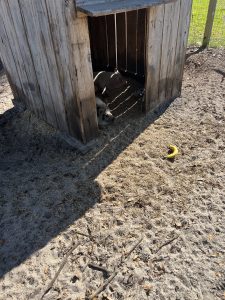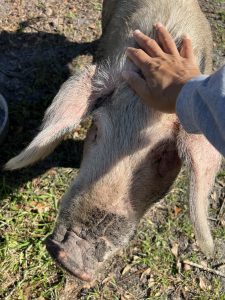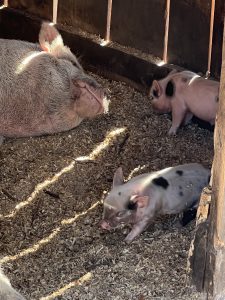Why Raise Pigs for Pork?
All you need to know for raising your own pigs for pork
Welcome to AProperFarm.com! Are you considering raising pigs for pork and embracing a sustainable lifestyle that promotes self-sufficient living? Look no further! In this comprehensive guide, we’ll walk you through the ins and outs of raising pigs for pork, from selecting the right breed to the rewards of homegrown pork. So, let’s dive in and discover the joys of why you should raise pigs for pork and a sustainable lifestyle!

It’s not necessary for raising pigs but we built a large hut for them to take shelter in out of the direct sun and the rain.
We’ve learned that even pigs can get a nasty sunburn.
So, you either need to have a place where they can shade themselves or build a hut.
We simply used lumber from trees that were cut down on our property.
When it comes to baby piglets you’ll have to have somewhere warm and dry for them to stay in so a little hut lined with sand or wood shavings is perfect
Why Raise Pigs for Pork?
Raising pigs for pork offers numerous benefits for those seeking a self-sufficient lifestyle. Here’s why it’s worth considering:
- Quality and Flavor:
- Homegrown pork: Raising your own pigs ensures the highest quality and freshest meat for your table.
- Superior taste: You’ll enjoy the rich flavor and tenderness of pork that comes from well-cared-for, humanely-raised pigs.
- Sustainable Living:
- Local food production: Raising pigs for pork reduces your reliance on industrial farming and supports sustainable, locally sourced food.
- Control over inputs: You have control over the pig’s diet and living conditions, allowing you to prioritize organic and environmentally friendly practices.
- Self-Sufficiency:
- Food security: Raising pigs provides a source of protein and nourishment for you and your family, contributing to a self-sufficient lifestyle.
- Utilization of resources: Pigs efficiently convert kitchen scraps and agricultural waste into valuable protein, making use of resources that might otherwise go to waste.
If you thought puppies were cute, silly, and playful then just wait until you see little piglets at play.
They bite at each other just like puppies. They wrestle, run, and jump on their siblings just like cute little puppies.
They are so cute in fact that my advice is to never name them or get too attached to them. You’ll never be able bbq them if you do.
Getting Started with Raising Pigs: The Essentials
Before diving into pig farming, it’s crucial to consider a few key factors. Here are the essentials to get you started:
- Selecting the Right Breed:
- Consider your goals: Determine whether you’re raising pigs for meat production, breeding, or both, and choose a breed that aligns with your objectives.
- Research breeds: Explore different pig breeds and their characteristics to find the one that suits your specific needs and environment.
- Housing and Space Requirements:
- Secure housing: Construct a sturdy, well-ventilated shelter that provides protection from the elements and predators.
- Ample space: Pigs need enough space to roam, root, and exercise. Aim for a minimum of 20 square feet per pig.
- Feeding and Nutrition:
- Balanced diet: Ensure a well-balanced diet that includes a mix of grains, fruits, vegetables, and high-quality commercial pig feed.
- Supplement with pasture: Allow pigs access to fresh pasture and forage, which enhances their diet and mimics their natural behavior.

Our pigs are fed organic grains and as many garden scraps as we can spare. Porky loves to eat broccoli leaves.
The Rewards of Homegrown Pork
Raising pigs for pork is a rewarding endeavor that offers a range of benefits. Here are some of the rewards you can enjoy:
- Flavorful, high-quality meat: Indulge in pork that surpasses store-bought varieties in taste, tenderness, and quality.
- Self-sufficient lifestyle

